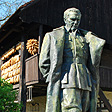VELIKI TABOR CASTLE
Tragic Love Story of Zagorje
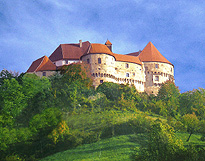 Standing
atop a low rising tree covered hill in Zagorje, the Veliki Tabor castle
is one of the most impressive late medieval fortress castles in
Croatia,
a medieval ring
tower
structure surrounded by farms and wine vineyards. Closed
for renovation for almost 3 years, Veliki Tabor re-opens to the public
in 2011. Dates for the building of castle are a little unclear and it
may
have been built on the site of a fort from Roman times. The earliest
walls and foundations at Veliki Tabor are from the 12th Century, but
the current form of the castle with its pentagonal tower and walled inner
baily date from the beginning of the 16th Century.
Standing
atop a low rising tree covered hill in Zagorje, the Veliki Tabor castle
is one of the most impressive late medieval fortress castles in
Croatia,
a medieval ring
tower
structure surrounded by farms and wine vineyards. Closed
for renovation for almost 3 years, Veliki Tabor re-opens to the public
in 2011. Dates for the building of castle are a little unclear and it
may
have been built on the site of a fort from Roman times. The earliest
walls and foundations at Veliki Tabor are from the 12th Century, but
the current form of the castle with its pentagonal tower and walled inner
baily date from the beginning of the 16th Century.
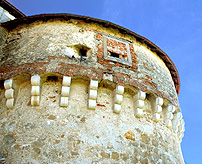 The Veliki Tabor castle was owned for much of its existence by the Rattkay
(Ratkaj) family from Hungary, granted estates in Croatia by the Viceroy
Johannes Corvinus. The master builders of Veliki Tabor castle remain
unknown. The oldest part of the castle is the central tower keep, originally
a self-standing two story structure used as a dwelling and defensive
fort. A triangular wall was added with a vantage point over the slope
of the hill for better defense. In 1537 a third story was added to the
tower keep, used as a granary, and the ground floor used as a winery,
while two floors used for living quarters.
The Veliki Tabor castle was owned for much of its existence by the Rattkay
(Ratkaj) family from Hungary, granted estates in Croatia by the Viceroy
Johannes Corvinus. The master builders of Veliki Tabor castle remain
unknown. The oldest part of the castle is the central tower keep, originally
a self-standing two story structure used as a dwelling and defensive
fort. A triangular wall was added with a vantage point over the slope
of the hill for better defense. In 1537 a third story was added to the
tower keep, used as a granary, and the ground floor used as a winery,
while two floors used for living quarters.
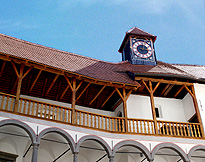 A
fortification ring with four defensive towers were built in two phases
in the mid-16th Century
along with the fortified entrance gate. In the 17th Century the upper
floor of the tower and other spaces were converted to residential palace
use. A mill, a chapel and a chaplain’s apartment are located in
the eastern tower. The walkways are lined with Renaissance Italianate
arches and red tiled roofs and the towers feature unique openings called
Czech windows. Later additions and renovations were added in the Baroque
period of the 18th Century, until the last of the ruling family died
out in 1793.
A
fortification ring with four defensive towers were built in two phases
in the mid-16th Century
along with the fortified entrance gate. In the 17th Century the upper
floor of the tower and other spaces were converted to residential palace
use. A mill, a chapel and a chaplain’s apartment are located in
the eastern tower. The walkways are lined with Renaissance Italianate
arches and red tiled roofs and the towers feature unique openings called
Czech windows. Later additions and renovations were added in the Baroque
period of the 18th Century, until the last of the ruling family died
out in 1793.
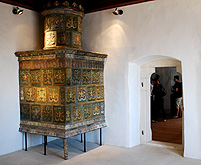 The castle of Veliki Tabor houses a museum which takes up most of its
floors, displaying cultural items, early medicinal cures, antique weapons,
armor and pottery. Notable are fireplaces and furnaces on the floors
from different periods of the castle’s life. The upper floors contain
bedroom furnishings from the Renaissance period, all moved to the castle
from elsewhere. The castle was owned for a time in 1930s by the Croatian
Painter Oton Ivekovic until the Second World War and after 1945, housed
war orphans cared for by nuns.
The castle of Veliki Tabor houses a museum which takes up most of its
floors, displaying cultural items, early medicinal cures, antique weapons,
armor and pottery. Notable are fireplaces and furnaces on the floors
from different periods of the castle’s life. The upper floors contain
bedroom furnishings from the Renaissance period, all moved to the castle
from elsewhere. The castle was owned for a time in 1930s by the Croatian
Painter Oton Ivekovic until the Second World War and after 1945, housed
war orphans cared for by nuns.
Tragic Veronica of Desinic
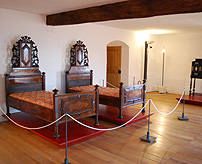 The more interesting legend of the castle is the romantic tragedy Veronica
of Desinic. During excavations at the castle in the 1980s, the skull
of a woman was discovered in the castle. A legend of the 15th Century
tells of the powerful Croatian ban, count Herman II of Celje, whose
son Frederick fell in love with a peasant beauty of the village of
Desinic
at the foot of the castle. Frederick already married to the daughter
of a powerful family, but divorced his wife to elope with the girl.
They were married in the family hunting lodge of Friedrichstein in
Slovenia,
near Kocevje, but the old man, threatened by the collapse of his alliance
with the family his son's wife, refused to recognize the marriage and
sent his soldiers to find the lovers and bring them back to Croatia.
He walled his son prisoner in a castle room until he would disavow
his love for Veronica, but Frederick kept his promise to her for four
years
of captivity.
The more interesting legend of the castle is the romantic tragedy Veronica
of Desinic. During excavations at the castle in the 1980s, the skull
of a woman was discovered in the castle. A legend of the 15th Century
tells of the powerful Croatian ban, count Herman II of Celje, whose
son Frederick fell in love with a peasant beauty of the village of
Desinic
at the foot of the castle. Frederick already married to the daughter
of a powerful family, but divorced his wife to elope with the girl.
They were married in the family hunting lodge of Friedrichstein in
Slovenia,
near Kocevje, but the old man, threatened by the collapse of his alliance
with the family his son's wife, refused to recognize the marriage and
sent his soldiers to find the lovers and bring them back to Croatia.
He walled his son prisoner in a castle room until he would disavow
his love for Veronica, but Frederick kept his promise to her for four
years
of captivity.
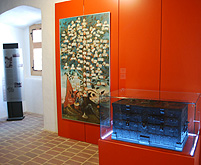 Finally,
as a last resort, Herman had the object of his son’s ardor tried as a witch. A trial court of nobles found her
innocent of the charge, her only crime being in love with his son, but
the old man would not be refused and applied the old test of witchcraft,
dunking her into water – if she floated to the top she was a witch,
if she sank, she was innocent. Thrust head first into a large tub of
water, she drowned - proved innocent of witchcraft, but dead. The skull
is held in the chapel of the castle. Although there is nothing to prove
it is actually that of Veronica of Desinic, it makes for a good story.
Finally,
as a last resort, Herman had the object of his son’s ardor tried as a witch. A trial court of nobles found her
innocent of the charge, her only crime being in love with his son, but
the old man would not be refused and applied the old test of witchcraft,
dunking her into water – if she floated to the top she was a witch,
if she sank, she was innocent. Thrust head first into a large tub of
water, she drowned - proved innocent of witchcraft, but dead. The skull
is held in the chapel of the castle. Although there is nothing to prove
it is actually that of Veronica of Desinic, it makes for a good story.
Visiting Veliki Tabor
Veliki Tabor Castle is located in Krapina-Zagorje just above the
little village of Desinic, about 30 miles from Zagreb. If previous
operations
are an indication - opening hours will be 10am to 6pm April to October
and 9am to 5pm October to April. Falconry shows and medieval recreations
are held at the castle in summer months. © Bargain
Travel Europe
Find best hotel and travel deals in Croatia on TripAdvisor
Web
Info
Veliki
Tabor
These articles are copyrighted and the sole property of Bargain Travel Europe and WLPV, LLC. and may not be copied or reprinted without permission.
SEE ALSO:
HOTEL CASTLE GJALSKI - ZAGORJE
LUZNICA
CASTLE – CONVENT ACCOMMODATIONS
TRAKOSCAN
CASTLE - ZAGORJE

